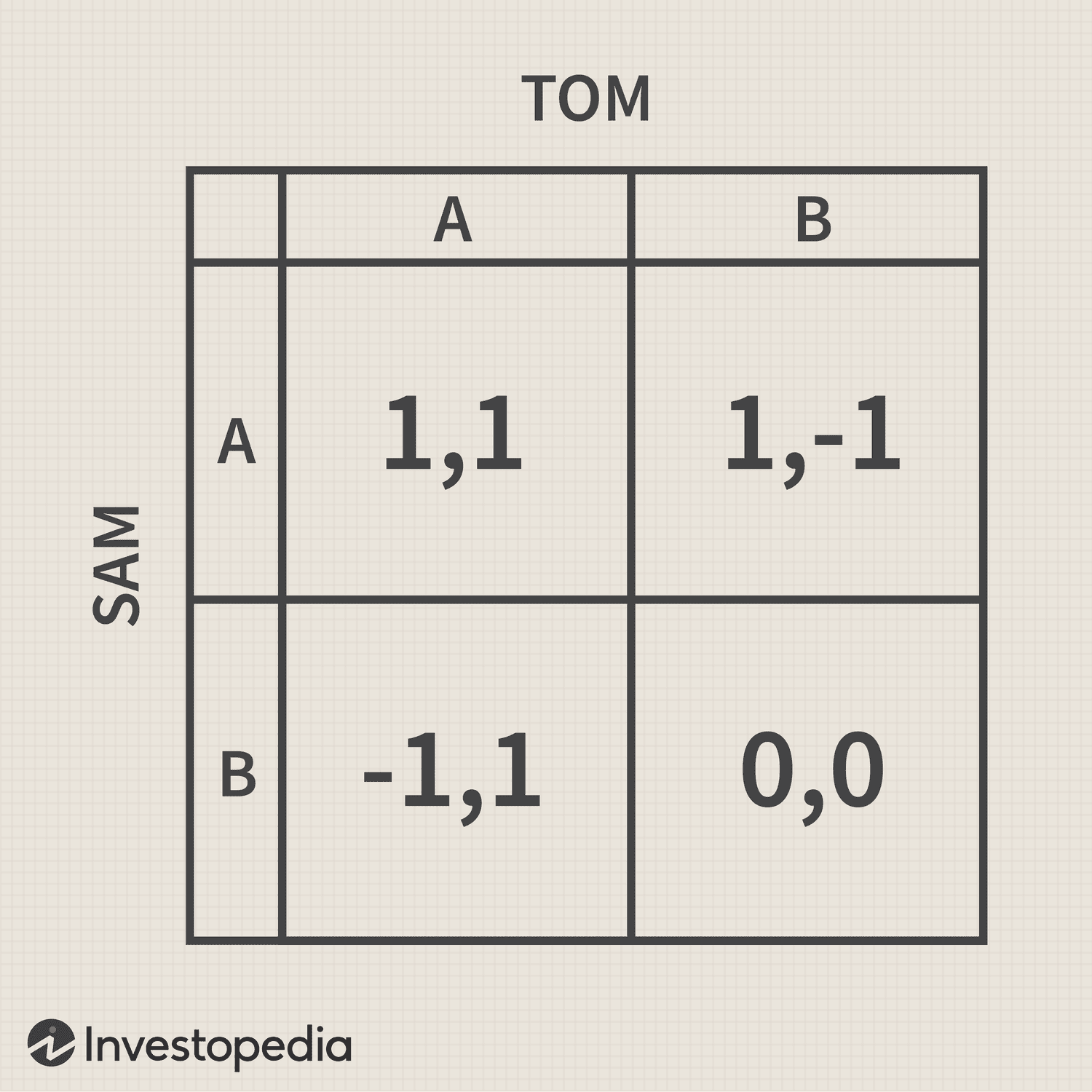Nash Equilibrium Calculator
| C (Player 2) | D (Player 2) | |
|---|---|---|
| A (Player 1) | ||
| B (Player 1) |
Nash Equilibrium Calculator – Analyze 2x2 Game Theory Strategies
How to Use the Nash Equilibrium Calculator
The Nash Equilibrium Calculator is an intuitive and easy-to-use tool that helps you analyze strategic decision-making in two-player games. In essence, this tool helps you find Nash equilibria, which are the stable points in a game where no player can improve their outcome by unilaterally changing their strategy. It works by taking the payoff matrices for two players and finding the strategies that make each player’s decision the best response to the other's.
To use the calculator, simply input the payoff matrices for both players. The matrix represents the possible outcomes of the game, depending on which strategies each player chooses. The calculator will automatically evaluate the best response for each player to every possible move of the other, helping you identify pure and mixed strategy Nash equilibria. Whether you’re analyzing a classic 2x2 game or testing your own custom matrices, the tool will guide you through the entire process in seconds.
What’s great about this calculator is its simplicity. You don’t need to be an expert in game theory to use it effectively. The calculator will give you instant feedback, showing whether there are any pure strategy Nash equilibria (where both players choose specific strategies) or if mixed strategy equilibria (where players randomize their strategies) come into play.

Image Source: Investopedia - Nash Equilibrium
Inputs Required:
Payoff Matrices: Enter the payoff matrices for both players. The calculator requires a 2x2 matrix for each player, representing their payoffs based on strategy combinations.
Player 1 Payoff Matrix: Manually input the values for Player 1’s payoff matrix. Each cell of the matrix corresponds to Player 1’s reward given the strategies chosen by both players.
Player 2 Payoff Matrix: Similarly, input the values for Player 2’s payoff matrix. This matrix reflects Player 2’s payoffs depending on the strategy combinations chosen by both players.
How to Calculate Nash Equilibrium:
Once the payoff matrices are entered, the calculator works by analyzing each player’s best possible responses to the strategies of the other. A Nash equilibrium occurs when both players choose strategies that are their best responses to each other’s choices. This means neither player has an incentive to change their strategy, as doing so would not lead to a better outcome for them.
The calculator checks each strategy pair to see if either player could benefit by switching their strategy, given what the other player is doing. If no player can do better by changing their choice, the strategy pair is considered a Nash equilibrium. The tool will highlight these equilibria and let you know if they involve pure strategies (where players pick a specific strategy) or mixed strategies (where players randomize their choices).
A Nash Equilibrium occurs when both players are playing mutual best responses to each other's strategies, creating a situation where neither player can gain by changing their own strategy unilaterally.
Benefits of Using the Nash Equilibrium Calculator
This Nash Equilibrium Calculator offers several key advantages:
- Accuracy: Delivers precise game theory calculations using mathematical logic, helping you explore game theory problems with confidence.
- Ease of Use: The interface is simple and user-friendly, making it accessible for both beginners and advanced users. Entering matrices is quick and straightforward.
- Instant Results: Once you input the payoff matrices, the calculator quickly analyzes the data and shows the Nash equilibrium strategies, so you can get immediate feedback.
- Versatility: Whether you’re studying classic 2x2 games or working on more complex matrices, the calculator adapts to your needs. You can test custom matrices and experiment with different scenarios.
Examples of Nash Equilibrium Calculations
Here are a few examples demonstrating how our calculator can be utilized:
- Calculate the Nash equilibrium for a simple 2x2 matrix game, such as the classic Prisoner's Dilemma or Battle of the Sexes.
- Analyze competitive game strategies using mixed and pure strategy outcomes, and understand how players might behave under different strategic conditions.
Example 1: Simple 2x2 Game
For a game with the following payoff matrices:
Player 1 Payoff Matrix:
[2, 0]
[1, 3]
Player 2 Payoff Matrix:
[1, 2]
[0, 4]
1. Enter the matrices into the calculator.
2. The calculator analyzes the data and determines the Nash equilibrium strategies.
3. Result:
The Nash equilibrium can be identified as (Strategy A, Strategy B) for Player 1 and Player 2 respectively.
Example 2: Competitive Game
Consider the following payoff matrices for a competitive scenario:
Player 1 Payoff Matrix:
[3, 1]
[0, 2]
Player 2 Payoff Matrix:
[2, 0]
[1, 3]
1. Input the matrices into the calculator.
2. The Nash equilibrium strategies will be calculated based on the players' best responses.
3. Result:
The Nash equilibrium may yield different outcomes based on the strategies selected by the players.
Explore More Game Theory Tools
Want to explore more tools? Check out our full collection of statistical and game theory calculators to enhance your learning and research.